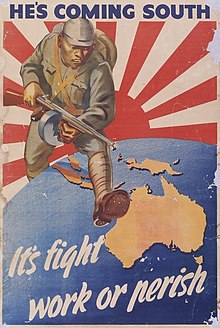Battle for Australia
| Battle for Australia | |||||||
|---|---|---|---|---|---|---|---|
| Part of Second World War during War in the Pacific | |||||||
 An Australian propaganda poster released in 1942. The poster was criticised for being alarmist when it was released and was banned by the Queensland government. | |||||||
| |||||||
| Belligerents | |||||||
|
|
| ||||||
| Commanders and leaders | |||||||
|
|
| ||||||
The Battle for Australia is a contested historiographical term used to claim a coordinated link between a series of battles near Australia during the Pacific War of the Second World War alleged to be in preparation for a Japanese invasion of the continent. Since 2008 these battles have been commemorated by Battle for Australia Day, which falls on the first Wednesday in September.
Historiography and commemoration[]
The Returned and Services League of Australia (RSL) and the Battle for Australia Commemoration National Council campaigned for over a decade for official commemoration of a series of battles fought in 1942, including the Battle of the Coral Sea, Battle of Milne Bay and Kokoda Track campaign, as having formed a "battle for Australia".[1] This campaign met with success, and in 2008 the Australian Government proclaimed that commemorations for the Battle for Australia would take place annually on the first Wednesday in September, with the day being designated "Battle for Australia Day".[1] This day recognizes "the service and sacrifice of all those who served in defense of Australia in 1942 and 1943".[2] The day is not a public holiday.[3]
Peter Stanley, the former principal historian at the Australian War Memorial, argues that the concept of a 'Battle for Australia' is mistaken as these actions did not form a single campaign aimed against Australia. Stanley has also stated that no historian he knows believes that there was a 'Battle for Australia'.[4] In a 2006 speech, Stanley argued that the concept of a Battle for Australia is invalid as the events that are considered to form the battle were only loosely related. Stanley argued, "The Battle for Australia movement arises directly out of a desire to find meaning in the terrible losses of 1942" and that "there was no 'Battle for Australia', as such", as the Japanese did not launch a coordinated campaign directed against Australia. Furthermore, Stanley stated that while the phrase "Battle for Australia" was used in wartime propaganda, it was not applied to the events of 1942 until the 1990s and that countries other than Australia do not recognize the "battle" as being part of the Second World War.[5][6]
See also[]
- Proposed Japanese invasion of Australia during World War II
- Operation FS
- Military history of Australia during World War II
Notes[]
- ^ a b Walters, Patrick (26 June 2008). "Battle won on dedicated Pacific war day". The Australian. Retrieved 13 February 2011.
- ^ "Anniversaries". Department of Veterans' Affairs. Archived from the original on 19 December 2011. Retrieved 23 December 2011.
- ^ Blenkin, Max (26 June 2008). "'Battle for Australia' Day in September". The Sydney Morning Herald. Retrieved 23 December 2011.
- ^ Stanley, Peter. "What 'Battle for Australia'?". The Drum. Australian Broadcasting Corporation. Retrieved 9 February 2011.
- ^ Peter Stanley (2006). "Was there a Battle for Australia?". Australian War Memorial Anniversary Oration, 10 November 2006
- ^ Stanley (2008), pp. 221–222
References[]
- Peter Stanley (2002). He's (Not) Coming South: The Invasion That Wasn't. Paper delivered to the Australian War Memorial conference Remembering 1942.
- Stanley, Peter (2008). Invading Australia. Japan and the Battle for Australia, 1942. Melbourne: Penguin Group (Australia). ISBN 978-0-670-02925-9.
- Stanley, Peter (30 August 2008). "Battle lines II: what invasion?". The Australian. Archived from the original on 27 July 2009. Retrieved 12 November 2008.
Further reading[]
- Rechniewski, Elizabeth (January 2010), "Remembering the Battle for Australia", PORTAL: Journal of Multidisciplinary International Studies, UTSePress, Sydney, Australia, 7 (1), ISSN 1449-2490
External links[]
- Conflicts in 1942
- Conflicts in 1943
- South West Pacific theatre of World War II
- 1942 in Australia
- Battles and operations of World War II involving Australia
- Military attacks against Australia